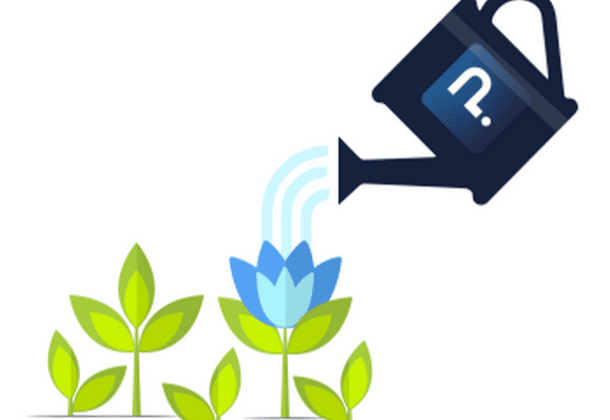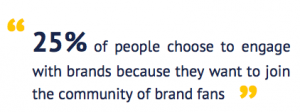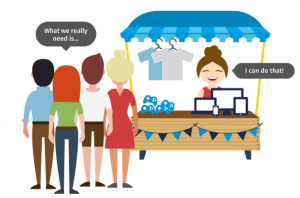
A healthy and strong customer relationship is one of the most effective ways to cultivate customer insight and maximize retention. So it’s surprising that so many companies encounter challenges in their ability (or inability) to find ways to keep their valued customers connected and engaged after they are recruited or after they have purchased a product or service. Every smart marketer knows that it’s easier to keep an existing customer than acquire a new one — and yet, far more focus and energy is expended on acquisition, and not enough on retention.
Nurturing a customer’s relationship is not an easy task, and it is in fact as a valuable practice, if not more valuable, as a recruiting one. But how can you do it in a meaningful and effective way so your customers will not only want to strengthen their relationships with you, but will take this bond even further and share their positive experiences with others? You want to invest in powerful acquisition? There’s nothing more impactful than an evangelistic customer.
To help address this question, I have compiled six easy to follow practices that can help you not only improve your relationships with your customers, but help you increase your customers’ retention rate and increase their willingness to share their experiences with your brand, products or services.
- Take a genuine interest in your customers
Simply put, take the time to pay attention to your customers. I can not stress how important it is for companies to take genuine interest in customers behaviors, preferences, habits, customs, and buying patterns. At the end of the day, what customers are looking for is solutions to their problems, and you can only provide that by thoroughly and deeply understanding them.
- Engage your customers in communities of members with similar attributes
By recruiting customers with similar attributes into online communities you increase your ability to not only have direct access to and collect insights from your target customers, but you are also able to create opportunities for community members to connect to each other and feel engaged with those who have similar needs and expectations (as well as interest in your brand and products).
 Another benefit to engaging your customers in segmented communities is that it allows them to feel special by being part of this private community of individuals that share similar thoughts, tastes, and experiences. By providing them a ‘safe’ place where they can freely share ideas on products and services, you create opportunities for your own company to collect customer feedback directly from your core customers… And all within one channel. QuestionPro Communities provides a platform where you can easily connect your customers in segmented communities and allows you to collect their valuable insights.
Another benefit to engaging your customers in segmented communities is that it allows them to feel special by being part of this private community of individuals that share similar thoughts, tastes, and experiences. By providing them a ‘safe’ place where they can freely share ideas on products and services, you create opportunities for your own company to collect customer feedback directly from your core customers… And all within one channel. QuestionPro Communities provides a platform where you can easily connect your customers in segmented communities and allows you to collect their valuable insights.
- Ask questions and listen attentively to the answers
Listening to your customers’ voices is probably the most common and important advice; however, it is still somehow neglected. Learning about your customers’ expectations and their views on your products and services is a most valuable practice that will help you understand your target market more thoroughly .
A good way to do this is by asking questions through surveys, polls, and discussion boards. Not only is valuable information to be found on such channels of communication, but also solutions for future developments or processes.
- Follow up
It is never enough to reinforce the importance of follow-up with customers. When asking a question, always follow up and let your customers know how much you value their time, their purchases, feedback, and insights. Even better, tell them exactly what you’re going to do with this newfound insight.
Sometimes a simple “Thank You!” email can do it. Other times, an update on the progress of that product development will make your customer feel like you are truly paying attention to his or her needs. And a simple follow up will make your customers feel valued and cared for.
- Plan and offer engagement activities
Planning periodic engagement activities is also a great practice. And adding reminders in your own schedule certainly helps you keep track of those activities.
A great example is scheduling weekly (or monthly or bi-monthly, depending on your capacity) idea discussion topics, with the same commitment you make in blogging regularly. I don’t mean you should blast your customers with ‘spam’ emails, but you can send them reminders to check your discussion board, according to your posting schedules. The key is to not allow for too much time pass by before you remind your customers that you are still listening to them and making efforts to engage.
- Make your customers feel part of the creation process of new products and/ or services
 One thing that most companies still lack is an initiative to integrate their customers in the creative and development process of their products and services. One way to do this is by showing your customers that not only their feedback has great value to you, but also showing them that their feedback has generated positive results, new or updated products, or a positive change in your services process that will improve their experience with your brand.
One thing that most companies still lack is an initiative to integrate their customers in the creative and development process of their products and services. One way to do this is by showing your customers that not only their feedback has great value to you, but also showing them that their feedback has generated positive results, new or updated products, or a positive change in your services process that will improve their experience with your brand.
For example, if you’re a game developer, why not ask your customers for new Ideas? Within a week you receive thousands of suggestions. You and your development team can funnel the suggestions, and develop the one that makes more financial sense to your business. It may not be exactly what your customers have suggested, but as long as you let them know that you have taken the time to consider their suggestions, they will feel as if their voices were ‘heard’, and they will appreciate your efforts in doing so. The end result is that they will feel more motivated to engage in the next discussion you propose to them, therefore resulting in a meaningful relationship.
By taking action with some or all of these six simple practices you are not only going to nurture a deeper and more meaningful relationship with your customers, but you will certainly raise in them an interest to maintain this relationship as well as motivate them to share their positive experiences within their network. What we need to remember is that human beings have a deep need to feel connected, understood, cared for, and appreciated for their actions and behaviors, and with customers it is no different.
Contact Us if you would like to hear more about how to create your own communities.







